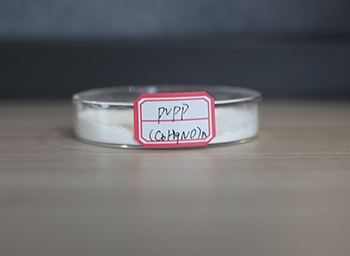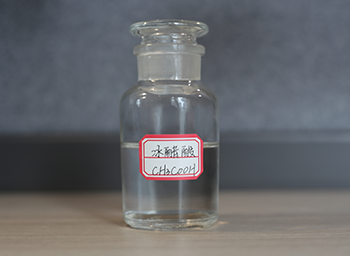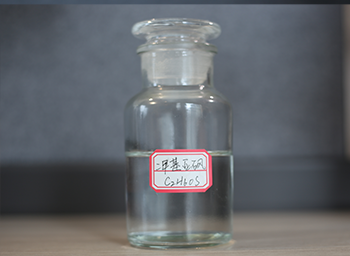Chemical name: acetic acid
CAS accession number:64-19-7
Specifications:
Appearance:colorless transparent liquid with pungent smell
Chemical formula:CH3COOH
Molecular weight :60.05
Density g/cm3 :1.05
Freezing point ℃ ≥ :57.21
Boiling point ℃ :118
Chloride(Cl) ppm≤ :3.6
Sulfate(SO4) ppm ≤ :19.6
Heavy metals(as Pb) ppm ≤ :10
Oxide :qualified
Nonvolatile residue % ≤ : 0.01
Formaldehyde ppm ≤ :30
Arsenic ppm≤ :2
Assay % ≥ : 99.0

◆Nature: colorless and transparent liquid, solidified into ice-like crystals at low temperature, with pungent smell; It is miscible with organic solvents such as water, ethanol, ether and carbon tetrachloride, and is insoluble in carbon disulfide. Flammable, corrosive and highly irritating, can cause burns to human body.
◆Application:In the food industry, acetic acid is used as an acidifier, flavoring agent and fragrance when making synthetic vinegar, the acetic acid is diluted to 4-5% with water, and various flavoring agents are added. The flavor is similar to that of alcoholic vinegar, and the manufacturing time is short and the price is cheap. As a sour agent, can be used for compound seasonings, preparation of vinegar, canned food, jelly and cheese, according to the production needs of appropriate use; You can also compose aroma enhancers for incense wine.
◆Storage method:Store in a cool and ventilated warehouse, away from fire; In winter, the storage temperature should be kept higher than 16 ℃ to prevent solidification and keep the container sealed. It should be stored separately from oxidant and alkali, and mixed storage should not be avoided.
What is glacial acetic acid
Acetic acid, also known as acetic acid (36%-38%), glacial acetic acid (98%), chemical formula CH3COOH, is an organic monic acid, the main component of vinegar. Pure anhydrous acetic acid (glacial acetic acid) is a colorless hygroscopic solid with a freezing point of 16.6 ° C (62 ° F) and becomes a colorless crystal after solidification. Its aqueous solution is weakly acidic and erosive, and the steam is irritating to the eyes and nose. High concentrations can corrode lesions, in the past, many self-prescribed drugs contain glacial acetic acid, and about 30% of the concentration is used for the treatment of gray nails. Glacial acetic acid can also treat verrucous lesions, but it is not very safe because other methods are being developed. Now public safety is very important, the clinical treatment has been basically banned, but the use of ice acetic acid to detect condyloma acuminatum is still used as a clinical inspection means.
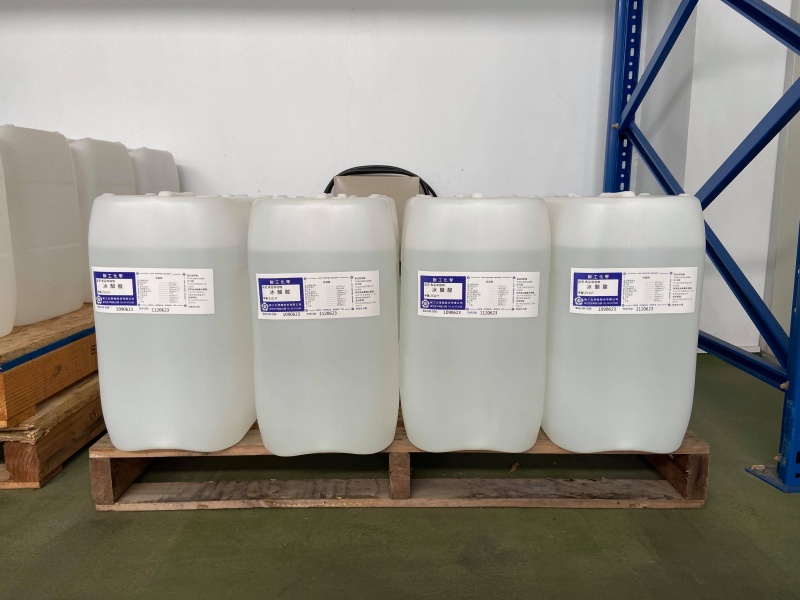
Glacial acetogenesis
Acetic acid can be used as acidity regulator, acidifier, pickling agent, flavor enhancer, fragrance and so on. It is also a good antimicrobial agent, mainly due to its ability to reduce the pH below the pH required for optimal microbial growth. Acetic acid is the earliest and most used sour agent in China. It is mainly used in compound seasoning, preparation of wax, canned food, cheese, jelly and so on. When used in seasonings, acetic acid can be diluted with water to 4%~5% solution and added to a variety of seasonings. The beverage made of vinegar as a sour agent and supplemented by pure natural nutrition and health products is called the international third generation beverage.
Toxicological data
Acute toxicity: LD50:3.3 g/kg(rat transoral); 1060mg/kg(rabbit percutaneous). LC50:5620ppm, 1h(mouse inhalation); 12.3g/m3,1h (inhaled by rats). The minimum amount of intoxication was 1.47mg/kg in the mouth, and symptoms of digestive tract appeared. Human oral 20 ~ 50g, lethal dose. Acetic acid at 80% concentration can cause severe skin burns in guinea pigs, 50% to 80% produce moderate to severe burns, less than 50% is very mild, and 5% to 16% concentrations never cause burns. Human can not tolerate more than 3min in 2~3g/m3 concentration. The oral lethal dose for humans is 20-50g.
Subacute and chronic toxicity: When the concentration of this product is about 100mg/m3, the chronic effect can cause inflammation in the nose, nasopharynx, eyelid and throat of workers, and even cause bronchitis. People inhaled (200 ~ 490) mg/m3× (7 ~ 12) years, there are eyelid edema, conjunctival congestion, chronic pharyngitis, bronchitis and other symptoms.
Mutagenicity: Microbial mutagenicity: E. coli 300ppm(3h). Sister chromatid exchange: human lymphocytes 5mmol/L.
Reproductive toxicity: The lowest oral toxic dose (TDL0) of rats was 700mg/kg(18 days after delivery), which had an effect on the behavior of newborn rats. The lowest toxic dose (TDL0) in the testis of rats was 400mg/kg(1d, male), which had an effect on the male fertility index.
Health hazard: The way of invasion is inhalation, ingestion and transdermal absorption. Irritant to nose, throat and respiratory tract when inhaled. It has a strong irritating effect on the eyes. Skin contact, mild erythema, severe cause chemical burns. Ingestion of concentrated acetic acid can lead to erosion in the mouth and digestive tract, and death can be caused by shock in severe cases.
Chronic effects: eyelid edema, conjunctival congestion, chronic pharyngitis and bronchitis. Long-term repeated contact can cause dry skin, degreasing and dermatitis.
Environmental harm: It is harmful to the environment and can cause pollution to water.
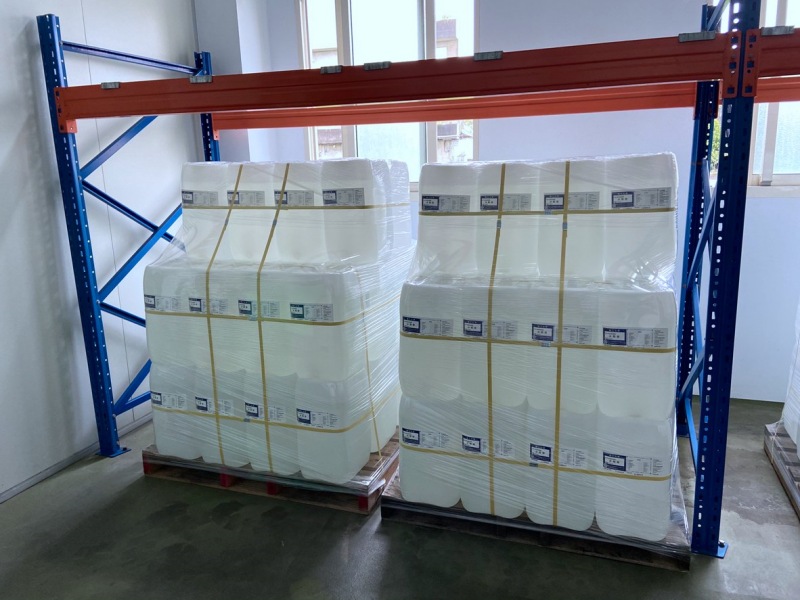
What harm does glacial acetic acid have to the human body
The harm of glacial acetic acid to the human body is mainly manifested as irritation to the skin and mucous membrane, and the specific situation should be analyzed according to the concentration of glacial acetic acid. The lower concentration of glacial acetic acid can usually cause slight irritation to the skin and mucosa, such as slight tingling, while the higher concentration of glacial acetic acid can cause greater irritation to the skin and mucosa, and even corrosion of local skin.
1, low concentration of glacial acetic acid: that is, less than 5% of glacial acetic acid, applied on the skin surface, mainly on the local skin surface of the stratum corneum tissue caused a certain irritation, may damage the skin, mucous membrane, causing local skin dry, for the face or vulva and other relatively weak skin parts, there may be mild stinging phenomenon. However, there is generally no obvious damage, so this situation is generally not particularly worrying. However, it is not recommended to use for a long time to avoid long-term stimulation, resulting in damage to local skin barrier function, which is not conducive to human health;
2, the higher concentration of glacial acetic acid: refers to more than 5% of glacial acetic acid, after applying on the skin surface may produce corrosive phenomenon. Because glacial acetic acid itself is an acidic liquid, it is itself a crystallization of acetic acid. If a high concentration of glacial acetic acid is applied to the skin surface, it may cause ulceration, erosion, exudation and other phenomena. In some individuals, it can irritate surrounding nerves and cause severe pain. Therefore, it is recommended that when choosing to use glacial acetic acid, you should follow the doctor's medical advice, and do not use it arbitrarily to avoid adverse effects.
The price of glacial acetic acid is about 2600 yuan -380 yuan/ton, each price changes according to the market, if you need to buy, please contact Shanghai art letter customer service.

